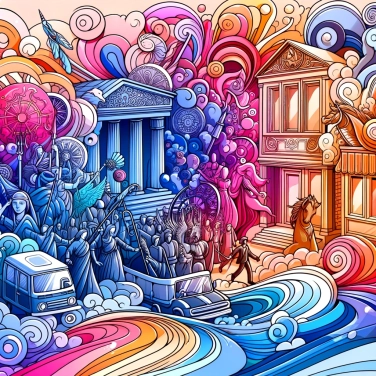Blue is the color of France due to the history of the monarchy. Blue and red were the colors of the city of Paris, and when King Hugues Capet ascended to the throne, blue became one of the colors of France.

The "French" blue first comes from the beginnings of the monarchy. In the medieval period, it was azure blue that symbolized the royal family, especially during the reign of the Capetians. In the Middle Ages, this fixation on royal blue became particularly established with the figure of King Louis IX, known as Saint Louis, who was associated with the blue color in his iconography. Later, during the French Revolution, blue became a key player. It was the color of the revolutionaries, chosen to contrast with the white of the monarchists. Blue, white, red: the French flag still reflects this history between monarchy and revolution.
Blue in France is a color deeply linked to the idea of freedom and peace. It also represents loyalty and hope—there's even talk of "French blue," an official shade that refers to national identity. It is often intuitively associated with positive notions: a cloudless sky, a calm sea, or even the famous blue shutters typical of houses in the South, symbols of warm hospitality and friendliness. In the past, blue also conveyed a certain wealth—until not so long ago, obtaining a beautiful blue dye required significant resources, and it was reserved for an elite. In short, a color with many faces, but always associated with a generally positive and very French sentiment.
During the French Revolution, blue became a strong symbol, representing the people of Paris fighting against royal authority. Associated with red, a revolutionary symbol, and white, the color of the monarchy, it formed the famous blue-white-red cockade. For the revolutionaries, wearing blue was a strong and committed choice, clearly affirming their belonging to the popular cause. Gradually, this color became a lasting symbol of republicanism: it became the mark of liberal, democratic ideas and the struggle against oppression. Even today, in the French political imagination, choosing blue often evokes this deep heritage of protest, freedom, and republican values.
The blue is clearly displayed on several well-known national emblems. Starting obviously with the French flag, the famous “blue-white-red,” where it evokes revolutionary ideals: liberty and democracy. This specific blue, a symbol of Paris and the French people during the Revolution, contrasts with the white representing the monarchy and the red symbolizing courage. It can also be found in the official French coats of arms and emblems, whether in the Republic's heraldry, the logos of official institutions, or the famous Gallic rooster, often painted in the national colors always including this notable blue. Even French military uniforms proudly display various shades of this color to express the historical attachment to the homeland.
Blue is everywhere in sports events in France; it is the official color of the national teams across all disciplines. Whether in football, rugby, basketball, or handball, we always hear about the "Blues." During major competitions like the World Cup, the Euro, or the Olympics, supporters love to paint their faces blue or wave tricolor flags heavily tinted with this color. The same goes for cultural events; major occasions like the national holiday on July 14 proudly display blue through fireworks, urban decorations, and traditional attire. Even the famous cycling race, the Tour de France, has its well-known "Blue Jersey," worn by the rider who leads the classification for the best climber, but only between 1989 and 1992, before being replaced by its timeless successor, the polka dot jersey. In short, blue has truly become a strong visual marker, unifying and expressing the pride and passion of the French in stadiums and in the streets.
The French term "bleu de travail" comes from the bright blue garment traditionally worn by workers, which was favored because the dark indigo blue concealed stains and dirt better.
The expression “Cordon Bleu” was originally used in France in the 16th century to refer to the prestigious decoration of the Order of the Holy Spirit, which was worn on a blue ribbon by the French noble elite. Later, it came to signify culinary excellence.
The blue known as "royal blue," adopted by the French monarchy in the 12th century, originates from the dye obtained from the woad plant, which was primarily cultivated in the Toulouse region.
Originally, the color associated with the Carolingian kings was red. It was only from the reign of Saint Louis in the 13th century that blue became predominant in symbolizing the French monarchy.
The colors blue, white, and red officially appeared together during the French Revolution. Adopted by decree in 1794, they symbolize the alliance between the Parisian people (blue and red) and the monarchy (white). The blue particularly represents Paris, the emblematic city of the Revolution.
Sure! Here’s the translation: "Yes, 'Bleu de France' is an officially defined shade. Its color is identified by the hexadecimal code #0055A4, recognized in heraldry and commonly used today in official emblems and national sports equipment."
Historically, the blue uniform, called 'horizon blue,' was widely adopted by the French army during World War I. This choice was mainly practical as it provided better concealment against enemies than the bright colors used previously.
Several notable French artists, particularly Yves Klein with his famous 'Klein Blue' or Paul Cézanne in his Provençal landscapes, have greatly contributed to making blue an emblematic color, symbolizing creativity, freedom, and artistic boldness in France.
French sports teams, particularly football teams, are referred to as 'Les Bleus' in reference to the main color of their jerseys. This blue derives from the national flag and thus symbolizes national identity and unity around common values.

No one has answered this quiz yet, be the first!' :-)
Question 1/5